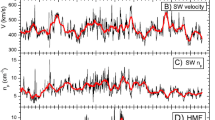Abstract
We report on observations of the solar luminosity variations in the Fe xii line (195 Å) over the period 1996–1999, which corresponds to the minimum and rising phase of the current 23rd solar cycle. The relatively or rather high temporal cadence and spatial resolution of the Extreme-ultraviolet Imaging Telescope (EIT) on board the Solar and Heliospheric Observatory (SOHO) allowed a nearly continuous measurement of intensity of different structures on the Sun. We find that a significant contribution to the longitudinal asymmetry, and thus to the 27-day variability of the solar EUV radiation, is produced by the numerous intermediate brightness elements that are globally distributed over large areas (up to about \( \sim \frac{2}{3} \) of the whole surface of the Sun). When activity is low, this component even becomes dominant over the contribution from localized active regions and bright points. This suggests that weak magnetic field areas outside active regions constitute an important factor through which solar activity modulates the solar EUV luminosity.
Similar content being viewed by others
References
Allen, C. W.: 1973, Astrophysical Quantities, University of London, The Athlone Press, London.
Chapman, G. A.: 1988, Adv. Space Res. 8, 21.
Defise, J.-M., Clette, F., Moses, J. D., and Hochedez, J.-F. E.: 1997, in H. S. Oswald and A. G. Mark (eds.), EUV, X-Ray, and Gamma-Ray Instrumentation for Astronomy VIII, Proc. SPIE 3114, 598.
Delaboudinière, J.-P. et al.: 1995, Solar Phys. 162, 291.
Gibson, E. G.: 1973, The Quiet Sun, Scientific and Technical Information Office, NASA, Washington.
Fligge, M., Solanki, S. K., Unruh, Y. C., Fröhlich, C., and Wehrli, Ch.: 1998, Astron. Astrophys. 335, 709.
Foukal, P. V. and Lean, J.: 1986, Astrophys. J. 302, 826.
Foukal, P. V. and Lean, J.: 1988, Astrophys. J. 328, 347.
Fröhlich, C.: 1999, private communication.
Fröhlich, C. et al.: 1997, Solar Phys. 175, 267.
Lean, J.: 1987, J. Geophys. Res. 92, 839.
Moses, J. D. et al.: 1997, Solar Phys. 175, 571.
Ogawa, H. S., Judge, D. L., McMullin, D. R., Gangopadlyay, P., and Galvin, A. B.: 1998, J. Geophys. Res. 103,1.
Rottman, G. J.: 1983, Planetary Space Sci. 31, 1001.
Warren, H. P., Mariska, J. T., and Lean, J.: 1998, J. Geophys. Res. 103, 12091.
Willson, R. C. and Hudson, H. S.: 1991, Nature 32, 42.
Author information
Authors and Affiliations
Rights and permissions
About this article
Cite this article
Veselovsky, I., Zhukov, A., Dmitriev, A. et al. Global Asymmetry of the Sun Observed in the Extreme Ultraviolet Radiation. Solar Physics 201, 27–36 (2001). https://doi.org/10.1023/A:1010369912487
Issue Date:
DOI: https://doi.org/10.1023/A:1010369912487




